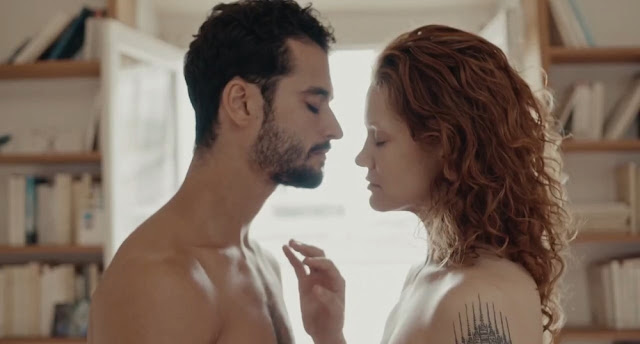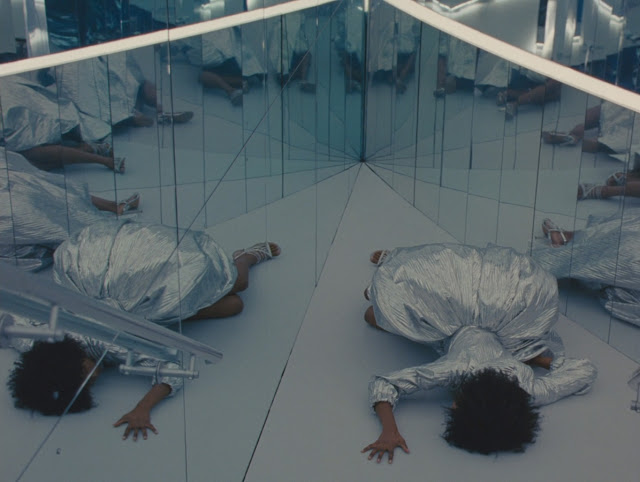This year, I was pretty generous with ratings, finding myself surrounded by almost 100 highly appreciated films (including some not-so-fresh, but newly discovered titles), which is why I decided to sort them out into eight thematic categories. As you may already assume, Thrills & Chills, Mysteries & Monstrosities is dominated by horror genre, yet there are a few dark thrillers, atmospheric / perplexing and sci-fi flicks included for the diversity sake. Down the Rabbit Hole is high on fantasy or deep in magic realism, whereas Future Imperfect & Disturbances in Kafkaland blends features of dystopian and/or Kafkaesque qualities. A variety of formally or stylistically challenging experiments oft-unsparing of the viewer come together in No Compromise! complemented by another ten unconventional, but more accessible flicks of Beautiful Weirdos. Named after Björk’s 1993 single, Big Time Sensuality is a domain ruled by (panesexual) Eros, though it holds some surprises, and Still Waters Run Deep synthesizes lyrical, methodical and slow cinema into a gentle organism. Finally, self-explanatory Action! is the most entertaining among these ‘selections’, with B-movie spirit soaring into the sky.
THRILLS & CHILLS, MYSTERIES & MONSTROSITIES
1. Mad God (Phil Tippett, 2021)
2. Antlers (Scott Cooper, 2021)
3. Far From the Apple Tree (Grant McPhee, 2019)
4. Junk Head (Takahide Hori, 2017)
5. The Night House (David Bruckner, 2021)
6. Gwleđđ / The Feast (Lee Haven Jones, 2021)
7. Come True (Anthony Scott Burns, 2020)
8. Some Southern Waters (Julian Baner, 2020)
9. Dýrið / Lamb (Valdimar Jóhannsson, 2021)
10. Limbo (Soi Cheang, 2021)
11. Invisible Alien (Jintao Lu & Dawei Zhang, 2021)
12. Nagwonui bam / Night in Paradise (Hoon-jung Park, 2020)
13. Ventajas de viajar en tren / Advantages of Travelling by Train (Aritz Moreno, 2019)
14. De Uskyldige / The Innocents (Eskil Vogt, 2021)
15. Hunted (Vincent Paronnaud, 2020)
16. The Night (Kourosh Ahari, 2020)
17. The Awakening of Lilith (Steven Adam Renkovish, 2021)
18. Aragne no Mushikago / Aragne: Sign of Vermillion (Saku Sakamoto, 2018)
19. Oxygen (Alexandre Aja, 2021)
20. The Dark and the Wicked (Bryan Bertino, 2020)
DOWN THE RABBIT HOLE
1. Śniegu już nigdy nie będzie / Never Gonna Snow Again (Malgorzata Szumowska & Michal Englert, 2020)
2. Ryū to sobakasu no hime / Belle (Mamoru Hosoda, 2021)
3. The Rainbowmaker (Nana Dzhordzhadze, 2008)
4. Batokin Yasokyoku / Nocturne of the Horse-headed Fiddle (Takeo Kimura, 2007)
5. Eld & lågor / Swoon (Måns Mårlind & Björn Stein, 2019)
6. Miao Xian Sheng / Mr. Miao (Lingxiao Li, 2020)
7. The Burial of Kojo (Blitz Bazawule, 2018)
8. Jiang Ziya / Legend of Deification (Teng Cheng & Li Wei, 2020)
9. The Green Knight (David Lowery, 2021)
10. Das kalte Herz / Heart of Stone (Johannes Naber, 2016)
11. Віддана / Felix Austria (Christina Sivolap, 2020)
12. Xin shen bang: Ne Zha chong sheng / Nezha Reborn (Ji Zhao, 2021)
13. The Blazing World (Carlson Young, 2021)
14. Cryptozoo (Dash Shaw & Jane Samborski, 2021)
15. Bright: Samurai Soul (Kyohei Ishiguro, 2021)
FUTURE IMPERFECT & DISTURBANCES IN KAFKALAND
1. Сентенция / Sententia (Dmitry Rudakov, 2020)
2. Den Næstsidste / The Penultimate (Jonas Kærup Hjort, 2020)
3. Služobníci / Servants (Ivan Ostrochovský, 2020)
4. The Wanting Mare (Nicholas Ashe Bateman, 2020)
5. Ja teraz kłamię / I Am Lying Now (Paweł Borowski, 2019)
6. Alephia 2053 (Jorj Abou Mhaya, 2021)
7. Baz ham sib dari? / Have You Another Apple? (Bayram Fazli, 2006)
8. Ukkili kamshat / The Owners (Adilkhan Yerzhanov, 2014)
9. Undergods (Chino Moya, 2020)
10. The Trouble with Being Born (Sandra Wollner, 2020)
NO COMPROMISE!
1. Az itt élő lelkek nagy része / Most of the Souls That Live Here (Ivan & Igor Buharov, 2016)
2. Северный ветер / The North Wind (Renata Litvinova, 2021)
3. Aapothkalin Trikalika / The Kali Of Emergency (Ashish Avikunthak, 2016)
4. The House That Eats the Rabbit (Cosmotropia de Xam, 2021)
5. The Lost Record (Ian F Svenonius & Alexandra Cabral, 2020)
6. Homo Sapiens Project (201) (Rouzbeh Rashidi, 2021)
7. Night Has Come (Peter van Goethem, 2019)
8. How the Sky Will Melt (Matthew Wade, 2015)
9. Annette (Leos Carax, 2021)
10. Das Massaker von Anröchte / The Massacre of Anroechte (Hannah Dörr, 2021)
BEAUTIFUL WEIRDOS
1. Titane (Julia Ducornau, 2021)
2. The Nowhere Inn (Bill Benz, 2020)
3. Hogtown (Daniel Nearing, 2014)
4. L’extraordinaire voyage de Marona / Marona’s Fantastic Tale (Anca Damian, 2019)
5. Безразличие / Indifference (Oleg Flyangolts, 2010)
6. The Goddess of 1967 (Clara Law, 2000)
7. Spoguli / In the Mirror (Laila Pakalniņa, 2020)
8. Prisoners of the Ghostland (Sion Sono, 2021)
9. Wolf (Natalie Biancheri, 2021)
10. Carro rei / King Car (Renata Pinheiro, 2021)
BIG TIME SENSUALITY
1. Aviva (Boaz Yakin, 2020)
2. Jìyuántái qihào / No. 7 Cherry Lane (Yonfan, 2019)
3. Show Me What You Got (Svetlana Cvetko, 2019)
4. Blanche comme neige / Pure as Snow (Anne Fontaine, 2019)
5. Split (Deborah Kampmeier, 2016)
6. Playdurizm (Gem Deger, 2020)
7. Senso ’45 / Black Angel (Tinto Brass, 2002)
8. Demonios (Marcelo D’Avilla e Marcelo Denny, 2019)
STILL WATERS RUN DEEP
1. Muukalainen / The Visitor (Jukka-Pekka Valkeapää, 2008)
2. Armugan (Jo Sol, 2020)
3. Lúa vermella / Red Moon Tide (Lois Patiño, 2020)
4. Das Mädchen und die Spinne / The Girl and the Spider (Ramon & Silvan Zürcher, 2021)
5. The Card Counter (Paul Schrader, 2021)
6. Ste. Anne (Rhayne Vermette, 2021)
7. The Man Who Knew 75 Languages (Anne Magnussen & Paweł Dębski, 2016)
8. Atarrabi & Mikelats (Eugène Green, 2020)
9. Ofrenda / Offering (Juan Mónaco Cagni, 2020)
10. Daughters (Hajime Tsuda, 2020)
11. Mariphasa (Sandro Aguilar, 2017)
12. Nadzieja / Hope (Stanislaw Mucha, 2007)
ACTION!
1. The Spine of Night (Philip Gelatt & Morgan Galen King, 2021)
2. Free Guy (Shawn Levy, 2021)
3. The Suicide Squad (James Gunn, 2021)
4. Майор Гром: Чумной Доктор / Major Grom: Plague Doctor (Oleg Trofim, 2021)
5. Zach Snyder’s Justice League (Zach Snyder, 2021)
6. The Witcher: Nightmare of the Wolf (Kwang Il Han, 2021)
7. Mortal Kombat (Simon McQuoid, 2021)
8. Mortal Kombat Legends: Battle of the Realms (Ethan Spaulding, 2021)
9. America: The Motion Picture (Matt Thompson, 2021)
10. Boss Level (Joe Carnahan, 2020)

































































